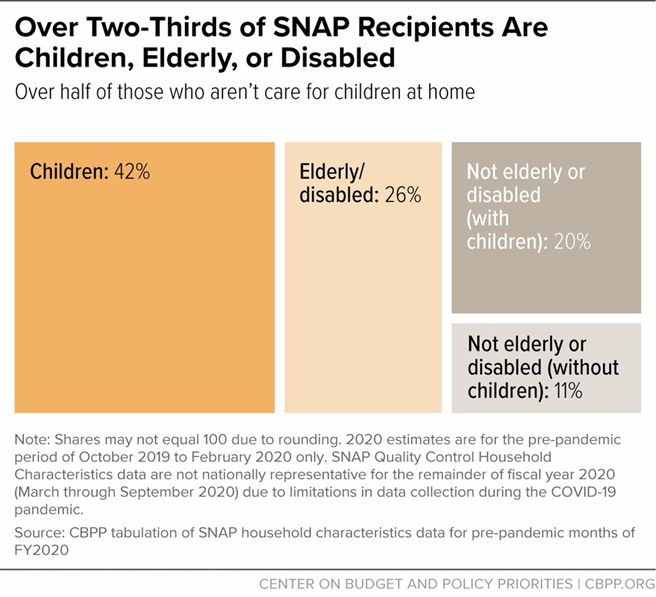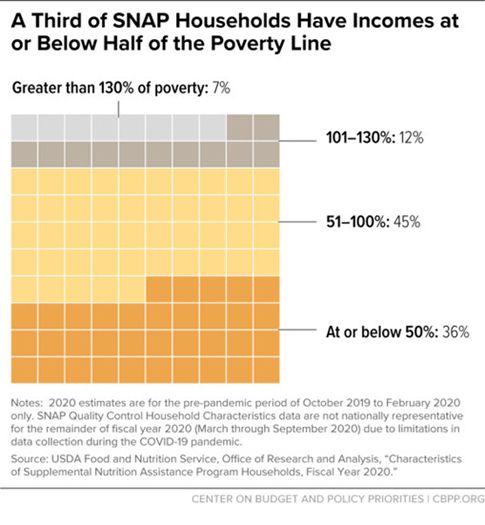Ty Jones Cox
@tyjonescox.bsky.social
Advocate, Mom, Wife, VP of Food Assistance at Center on Budget and Policy Priorities, focused on racial, gender & economic justice & believes everyone should have enough food.
Today’s rulings confirm what’s been clear all along: the Administration has been sitting on billions of available dollars that it is legally required to use to fund November benefits for the 1 in 8 Americans who need SNAP to afford their groceries.

October 31, 2025 at 8:12 PM
Today’s rulings confirm what’s been clear all along: the Administration has been sitting on billions of available dollars that it is legally required to use to fund November benefits for the 1 in 8 Americans who need SNAP to afford their groceries.
Preventing states from waiving SNAP's harsh work requirement based on local labor market conditions means cutting people off SNAP after only 3 months even if there aren't jobs available. Many people need longer to find work, especially in a weak economy, which may be coming.

May 6, 2025 at 8:01 PM
Preventing states from waiving SNAP's harsh work requirement based on local labor market conditions means cutting people off SNAP after only 3 months even if there aren't jobs available. Many people need longer to find work, especially in a weak economy, which may be coming.
1.4 million adults aged 55-64 without children would also be at risk of having their food benefits taken away. Older workers face age-related employment discrimination & more than half of low-income adults this age report a health condition that may limit their ability to work.

May 6, 2025 at 8:01 PM
1.4 million adults aged 55-64 without children would also be at risk of having their food benefits taken away. Older workers face age-related employment discrimination & more than half of low-income adults this age report a health condition that may limit their ability to work.
This would take away entirely or reduce food assistance for millions of people, making it hard for them to afford basic needs & worsening hunger. Who’s hurt? Families with children, older adults, people with disabilities, veterans, small business owners & workers. x.com/meredithllee...

May 6, 2025 at 8:01 PM
This would take away entirely or reduce food assistance for millions of people, making it hard for them to afford basic needs & worsening hunger. Who’s hurt? Families with children, older adults, people with disabilities, veterans, small business owners & workers. x.com/meredithllee...
House Republicans are reportedly considering expanding SNAP’s harsh work requirement to older adults aged 55+. This would take food away from people who often face work-limiting health conditions & age-related employment discrimination—without improving their job prospects.

April 3, 2025 at 6:50 PM
House Republicans are reportedly considering expanding SNAP’s harsh work requirement to older adults aged 55+. This would take food away from people who often face work-limiting health conditions & age-related employment discrimination—without improving their job prospects.
Most SNAP participants who can work, do—just in jobs that don’t pay enough for them to afford groceries. About 10% of all workers live in households that used #SNAP to put food on the table in the last year. In some jobs like cooks & cashiers, 1 in 5 workers participate in SNAP.

April 3, 2025 at 5:53 PM
Most SNAP participants who can work, do—just in jobs that don’t pay enough for them to afford groceries. About 10% of all workers live in households that used #SNAP to put food on the table in the last year. In some jobs like cooks & cashiers, 1 in 5 workers participate in SNAP.
When we talk about SNAP & work, it’s important to remember who most SNAP participants are. Over two-thirds of SNAP participants are kids, seniors, and people with disabilities. And SNAP benefits are modest: only $6.20 per person per day, on average.

April 3, 2025 at 5:53 PM
When we talk about SNAP & work, it’s important to remember who most SNAP participants are. Over two-thirds of SNAP participants are kids, seniors, and people with disabilities. And SNAP benefits are modest: only $6.20 per person per day, on average.
Achieving a $230 billion cut by taking SNAP away entirely from some people would require ending eligibility for more than 9 million people in an average month. Almost 90% of SNAP participants are seniors, people with disabilities, or families with kids.

February 12, 2025 at 7:24 PM
Achieving a $230 billion cut by taking SNAP away entirely from some people would require ending eligibility for more than 9 million people in an average month. Almost 90% of SNAP participants are seniors, people with disabilities, or families with kids.
Average SNAP benefits are currently only about $6.20 per person per day. Achieving a $230 billion cut by reducing benefits would slash that average benefit to only $4.80. SNAP households have extremely low incomes. They don’t have room in their budgets to make up that loss.

February 12, 2025 at 7:24 PM
Average SNAP benefits are currently only about $6.20 per person per day. Achieving a $230 billion cut by reducing benefits would slash that average benefit to only $4.80. SNAP households have extremely low incomes. They don’t have room in their budgets to make up that loss.
Households who receive #SNAP have very low incomes. More than 80% of SNAP households have gross incomes at or below the poverty line ($25,820 for a family of 3 in 2025). To be clear these are the people being asked to pay their “fair share.”

February 11, 2025 at 8:57 PM
Households who receive #SNAP have very low incomes. More than 80% of SNAP households have gross incomes at or below the poverty line ($25,820 for a family of 3 in 2025). To be clear these are the people being asked to pay their “fair share.”
#SNAP not only supports better health outcomes today, but it also supports improved health, education, and economic outcomes in the long-term for participating children.

February 5, 2025 at 10:13 PM
#SNAP not only supports better health outcomes today, but it also supports improved health, education, and economic outcomes in the long-term for participating children.
#SNAP is also linked with lower overall health care expenditures. On average, low-income adults participating in SNAP incur about $1,400—nearly 25 percent—less than non-participants in medical care costs each year.

February 5, 2025 at 10:13 PM
#SNAP is also linked with lower overall health care expenditures. On average, low-income adults participating in SNAP incur about $1,400—nearly 25 percent—less than non-participants in medical care costs each year.
Because food insecurity is associated with a higher risk of chronic health conditions & other adverse health outcomes, it's unsurprising that #SNAP is linked to better health for participants.

February 5, 2025 at 10:13 PM
Because food insecurity is associated with a higher risk of chronic health conditions & other adverse health outcomes, it's unsurprising that #SNAP is linked to better health for participants.
But #SNAP, which helps low-income households afford adequate food, is one of our most powerful tools to address this problem. SNAP is highly effective at reducing both food insecurity & poverty.

February 5, 2025 at 10:13 PM
But #SNAP, which helps low-income households afford adequate food, is one of our most powerful tools to address this problem. SNAP is highly effective at reducing both food insecurity & poverty.
With some Republicans considering cuts & harmful policy changes to #SNAP this year, let’s take a closer look at SNAP’s links to better health & lower health care costs.

February 5, 2025 at 10:13 PM
With some Republicans considering cuts & harmful policy changes to #SNAP this year, let’s take a closer look at SNAP’s links to better health & lower health care costs.
States currently split the cost of administering SNAP 50/50 with the federal government. But the vast majority of SNAP spending is on benefits, not administrative costs. (It’s a very efficient program!) The federal government pays 100% of benefit costs.

January 31, 2025 at 3:41 PM
States currently split the cost of administering SNAP 50/50 with the federal government. But the vast majority of SNAP spending is on benefits, not administrative costs. (It’s a very efficient program!) The federal government pays 100% of benefit costs.

